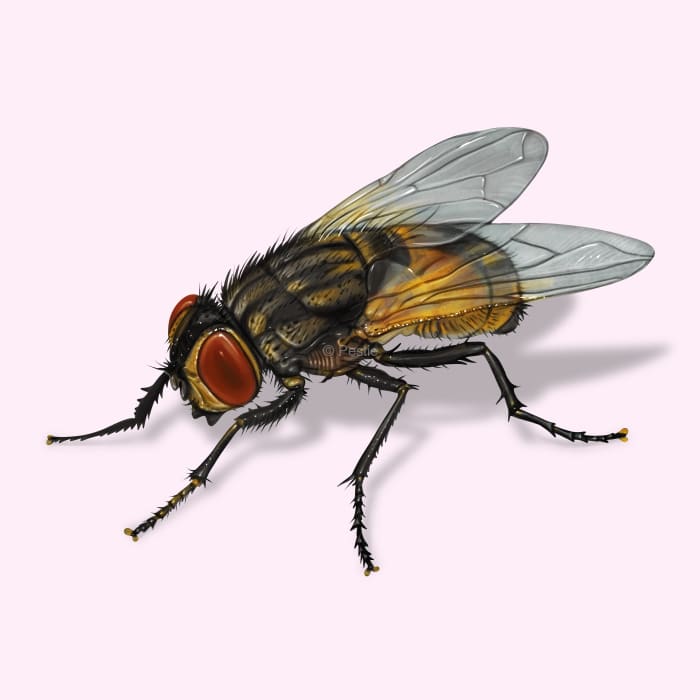How to identify and treat house flies

Shoo fly: What every homeowner needs to know about house flies
Even with the windows shut and the screen door closed, flies always find a way to get inside our homes. It's like they know how to perfectly annoy you when you want to relax and not be bothered. Despite their small size, these creatures have a fascinating life story, from their speedy growth to their surprisingly diverse diet. They are the most common flies that we find in our homes. But they are more than just a nuisance. They can be harmful to our health, too!
Why?
House flies lay their eggs in whatever rotting food or trash they can find. It seems like the smellier, the better! While crawling around in that filth, they pick up all sorts of bacteria and pathogens and then land on our food!
The eggs hatch into maggots that make quick work of any food or rotting organic matter they can find. They grow incredibly fast, only needing six days to go from egg to adult! The maggots have hook-like teeth that tear into their food. After molting four times, they will become pupae and emerge as adults.
They're not picky eaters at all. House flies feast on a wide range of food, from sugary substances to decaying organic matter. They're particularly fond of anything fermenting or rotting.
How to identify house flies
House flies are easy to spot flying around your home or in a trash can. They have dark gray bodies with large red eyes. You'll also notice four racing stripes or dark bands going down their backs. They have stiff bristles on their body. Also, they have a proboscis with a sponge-like mouthpart on the tip.
The maggots are cream-colored and start out pretty small but can grow to be 3/8 inch long.
If you start noticing these flies buzzing around more than usual, especially near food or waste areas, it might be a sign you've got an infestation. Key symptoms include seeing the flies themselves in large numbers, finding their maggots in moist, decaying organic matter, and noticing an increase in activity around garbage or pet waste areas.
How big are house flies?
House flies typically grow to about ¼ inch in length.
What other flies look like a house fly?
Other flies that might resemble house flies include:
- Cluster flies
- Blue bottle flies
- Green bottle flies
- Flesh flies
All of these flies look very similar but can be controlled with the same tactics and strategies.
Where do they live?
You can find house flies everywhere! They are common throughout the United States and can be in both hot and cold climates. They are closely connected to human activity and can be found hanging out around all the dirty places, including:
- Near open food
- Trash cans
- Animal bedding
- Decomposing organic material
- Around pet waste
How to get rid of house flies
House flies will be coming from the outside and entering your home. So, the best way to keep them out of your house is to ensure there are no openings they can get through. This includes:
- Sealing up gaps and cracks around doors and windows
- Repairing window screens and screen doors
- Putting screens on vents
Additionally, you want to eliminate any food sources they may be looking for. Some tips for this are:
- Clean up any food spills
- Don't keep food uncovered
- Remove trash frequently from the home
- Clean out and sanitize your trash can inside and outside regularly
- Clean up any animal waste
You can also spray an insect barrier around and inside the home to prevent flies and other insect pests from entering your home. Consider subscribing to Pestie's DIY, pro-grade pest control plan if you want an easy way to keep pests out of your home all year.
Treat houseflies with Pestie
If you're still having trouble keeping houseflies away, the best option is to use a pro-grade, effective pest control solution like Pestie.
Pestie is a do-it-yourself pest control solution that's specially designed to keep houseflies and other pests away from your home.
With Pestie, you can rest easy knowing that your living space is protected and free of creepy crawlies. And the best part? It's designed for people, pets, and the planet, so you can say goodbye to harsh chemicals and hello to peace of mind!
- Save hundreds compared to traditional annual pest plans
- People, pet, and planet-friendly
- Pro-grade customized formulas
Quick facts
How dangerous are Houseflies?
Medium danger risk
While house flies themselves are not harmful, they can carry and spread diseases to humans by contaminating food and surfaces. They have been known to vector over 100 different pathogens to humans via contact.
- Scientific name
Musca domestica
- Other common names
Little House Fly
- Colors
Dark gray
- Life span
About 28 days
- Diet
Organic matter, human food, trash, animal feces
Did you know that in WWII, the Japanese used insects in biological warfare? They dropped bombs on the Chinese that contained contaminated house flies that carried a bacterium that causes cholera. It killed over 200,000 people due to this disease.








